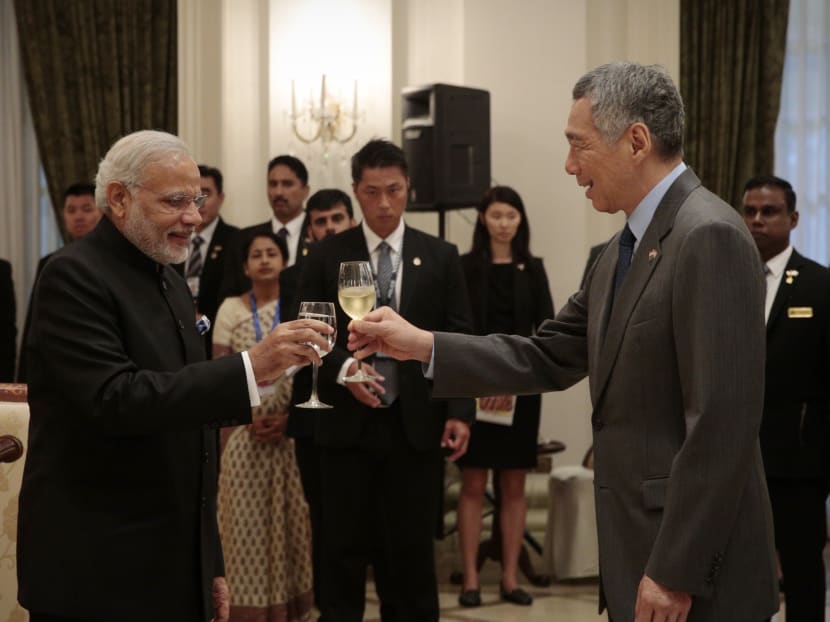India very much a part of Singapore’s history: PM Lee
SINGAPORE — India has been very much a part of Singapore’s history, and today, the Republic has a thriving community of Indians who are well-integrated in the community and form an essential part of the country’s multi-racial, multi-religious mix, said Prime Minister Lee Hsien Loong.
SINGAPORE — India has been very much a part of Singapore’s history, and today, the Republic has a thriving community of Indians who are well-integrated in the community and form an essential part of the country’s multi-racial, multi-religious mix, said Prime Minister Lee Hsien Loong.
“Long before the term ‘soft power’ was coined, Indian influences left their mark on our traditions and landscape,” said Mr Lee in a toast speech at a lunch he hosted for visiting Indian Prime Minister Narendra Modi, adding that even the names Indonesia and Indo-China attest to India’s far reaching influence.
Mr Lee further noted Singapore was part of the Majapahit Empire, one of the Indianised kingdoms in Southeast Asia way back in 13 century. Islam had also come to the region through India, he added.
Singapore, Mr Lee said, looked forward to India playing an important role in the region, promoting regional security and peace, integrating its economy with the rest of the region, and helping to shape an open and inclusive regional architecture.
“We believe India is a great Asian country that has a lot to contribute to the region and we wish India well in its reforms and development,” he said.
“We hope to develop our economic cooperation, air links, and broader cooperation and we are happy to support India’s development where we can, because this is a mutually beneficial relationship,” he added.
Earlier, Mr Lee had presented Mr Modi with a copy of the Tamil Murasu article on India’s recognition of Singapore as an independent country. The date of article was August 11 1965, just two days after Singapore’s separation from Malaysia, and this “demonstrates the longstanding and special friendship between India and Singapore,” said Mr Lee.
He added that the founder of Tamil Murasu, Mr G Sarangapany, had come to Singapore from Tamil Nadu in 1924 when he was 21 to work as a book-keeper.
Mr G Sarangapany fought for social reform for poorly educated immigrant Indians here, Mr Lee noted, and set up Tamil Murasu in 1935 with the paper sold at one cent a copy so that the poor could read it too.
“And indeed because of leaders like him, Singapore has today a thriving community of Indians who are well-integrated in our society and form an essential part of our multi-racial, multi-religious mix,” said Mr Lee.
He cited other pioneers such as Mr Rajabali Jumabhoy, a Gujarati businessman who was the first president of the Singapore Indian Chamber of Commerce and Industry, as well as Maulana Abdul Aleem Siddique, an Indian Muslim from Meerut India who pioneered the establishment of social welfare organisations like Jamiyah in 1932 and Singapore’s Inter-Religious Organisation in 1949 as well as Sikhs who contributed in many different fields such as in the judiciary and the armed forces.
“Singapore also have had five Indian-origin Foreign Ministers who represent Singapore and Singaporean interests abroad,” said Mr Lee, referring to Mr S Rajaratnam, Mr S Dhanabalan, Prof S Jayakumar, Mr K Shanmugam and current Minister for Foreign Affairs Vivian Balakrishnan.
In his toast speech at the lunch, Mr Modi said that there was no other place in the world like Singapore.
“Singapore is the metaphor of the reality of dreams. And Singapore achieved it without a vast expanse of territory, or the gifts of nature,” he said.
“For this region, it is a symbol of aspiration for people, and a source of inspiration for nations around the world.”
PM Modi presented Mr Lee a reproduction of a map of the island of Singapore dating back to 1849.
Measuring 52 inches x 52 inches and based on a survey that was done during 1842-45, the map depicts topographical details of parts of Singapore and a description of various points around Singapore town above the level of low water spring tides.
The reproduction was done from the cartographic collection of the National Archives of India in New Delhi.







